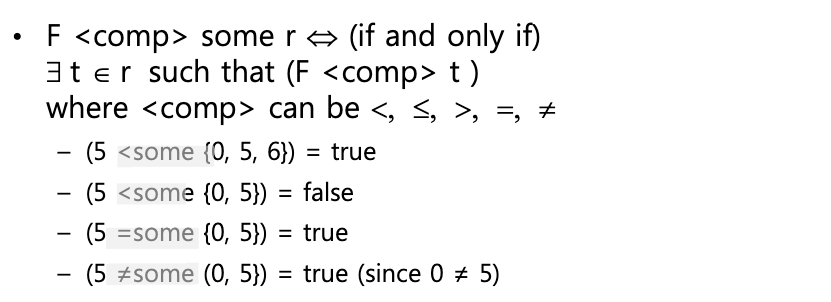In
단일 값(single value)이 다수 값에 속하는가를 검사
- Get names and salaries of professor who has ID with 10 or 21 or 22
Select name, salary from professor where pID in (10, 21, 22); // 이 안에 존재하면 참```
comparision
값 하나 간의 비교는 간단하나, 값 하나와 여러 값 간의 비교는 간단하지 않다. 그래서 some, any, all연산자를 지원한다
- example
- (1>2) : false
- (3 > all {2,3}) : false // 3>2이고, 3>3이어야 참
- (3 > some {2,3}) : true // 3>2이기 때문에 참
- (3 > any {2,3}) : any = some
- any = some
- any (= some)은 “속한다” 의미의 in 연산자와 동일
- not some 다수 개의 중의 하나와도 같이 않으면 참인데, ”not in"는 전체에 속하지 않아야 참이므로,동일하지 않다.
- 등호와 사용
set comparision EX
- Find professor names with salary greater than that of some (at least one) professor in CS department
// ver1
Select name, salary
from professor as T, professor as S
where T.salary > S.salary and S.deptName='CS'
//ver2
Select name
from professor
where salary > some (select salary
from professor
where deptName = 'CS');- Find the professor names whose salary is greater than the salary of all professors in CS department
Select name
from professor
where salary > all (select salary
from professor
where deptName='CS');Correlated Subqueries
내부 중첩질의에서 외부 테이블을 참조하면, 이를 correlated subquery라고 부른다.
- correlated subqueries 사용시
- subquey를 외부 테이블의 각 튜플 값에 대해 evaluated되어야
- 그래서 Time-consuming evaluation
exists
인자 형태로 subquery 결과가 존재하면 참
-
정의
- exists r : r이 공집합이 아닐때 참
- not exists r : r이 공집합일때만 참
-
예시
-
Find all course numbers taught in both the Fall 2009 semester and in the Fall 2010 semester
Select s.cID from teaches as S where S.semester='Fall' and S.year=2009 and exists (select * from teaches as T where T.semester='Fall' and T.year=2010 and S.cID = T.cID);```
-
not-correlated 된 subquery에 exists를 쓰는것은 무의미하다
Select distinct sID from student where exists (select cID from course whree deptName='CS'); // 아래 문장과 동일하다 select distinct sID from stuent;```
-
for all = not exists
sql에서 for all은 제공하지 않으므로, not exists(...except ...) 로 표현한다
for all = not exists(반드시 공집합이 나오는 것)
- Find all student IDs and names who have taken all courses offered in ‘CS’ department
Select sID, name from student as S where not exists( (select cID from course where deptName='CS') except (select T.cID from takes as T where S.sID = T.sID) );// CS가 제공하는 강의 주 어떤건 듣고, 어떤걸 안들으면 거짓 리턴```
unique
인자형식으로 표현되는 서브질의 결과에 중복성이 있는지를 검사
unique(r)에서 만약 r이 공집합이면(즉, 질의 결과가 없으면) true
- ⚠️ null 값을 가지는 터플은 중복으로 나와도 unique하다고 판별한다. 터플 중의 속성이 한 개라도 널 값을 가지면 동일하지 않다고 판별하므로 주의해야
- unique(공집합) = true
- Find all courses that were offered at most once in 2009
//ver1 Select C.cID from course as C where unique(select T.cID from teaches as T where C.cID=T.cID and T.year=2009); // ver2 Select C.cID from course as C where 1 >= (select count(T.cID) from teaches as T where C.cID=T.cID and T.year=2009);```
from 내 subquery
-
Find department name and the average salary of the professors of the department where the average salary is greater than 6900
// ver 1 Select deptName, avg(salary) from (select deptName, avg(salary) as avgSalary from professor group by deptName) where avgSalary > 6900; // ver 2 Select deptName, avgSalary from (select deptName, avg(salary) from professor group by deptName) as deptAvg(deptName, avgSalary) where avgSalary > 6900;```
-
Find the maximum total salary of department across all departments
// ver1 Select max(totalSalary) from (select deptName, sum(salary) from professor group by deptName) as deptTot(deptName, totalSalary); //ver2 Select sum(salary) from professor group by deptName having sum(salary) >= all(select sum(salary) from professor group by deptName);```
with 절
SQL 문장의 결과를 임시 저장
-
Find the department name with the maximum budget, along with its budget
//ver 1 With maxBudget(value) as (select max(budget) from department) select deptName, budget from department, maxBudget where department.budget = maxBudget.value; // ver2 Select deptName, budget from department where budget=(select max(budget) from department);```
-
Find all departments where the total salary is greater than the average of the total salary at all departments
with deptTotal(deptName, value) as (select deptName, sum(salary) from professor group by deptName), deptTotalAvg(value) as (select avg(value) from deptTotal) select deptName from deptTotal, deptTotalAvg where deptTotal.value > deptTotalAvg.value;```
scalar subquery
결과 테이블이 하나의 속성으로 이루어지고 동시에 하나의 튜플만을 가지면 서브질의가 연산 식에서 값이 반환되는 어떤 곳이라도 나타날 수 있게 한다. 이러한 서브질의를 scalar subquery라고 함
- To find department names along with the number of professors
Select deptName, (select count(*) from professor p1 where d1.deptName = p1.deptName) from department d1;```- select 절 안의 deptName과 (...) 이 두 개 동등하게 scalar이기 때문에 select A, B로쓸 수 있다.


